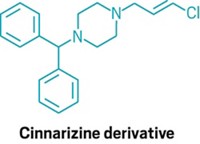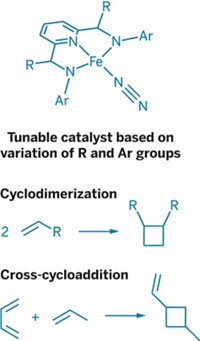Advertisement
Grab your lab coat. Let's get started
Welcome!
Welcome!
Create an account below to get 6 C&EN articles per month, receive newsletters and more - all free.
It seems this is your first time logging in online. Please enter the following information to continue.
As an ACS member you automatically get access to this site. All we need is few more details to create your reading experience.
Not you? Sign in with a different account.
Not you? Sign in with a different account.
ERROR 1
ERROR 1
ERROR 2
ERROR 2
ERROR 2
ERROR 2
ERROR 2
Password and Confirm password must match.
If you have an ACS member number, please enter it here so we can link this account to your membership. (optional)
ERROR 2
ACS values your privacy. By submitting your information, you are gaining access to C&EN and subscribing to our weekly newsletter. We use the information you provide to make your reading experience better, and we will never sell your data to third party members.
Synthesis
Halogen-Induced Cyclization
Long-sought enantioselective reaction leads to halogenated steroidal compounds
by Stu Borman
February 26, 2007
| A version of this story appeared in
Volume 85, Issue 9

SOME MARINE organisms have a knack for making steroidal compounds containing halogens. Chemists have long tried to do the same thing, because such compounds can be useful, for example, in treating skin diseases. Now, Japanese researchers have made a significant advance in imitating how such compounds are made in nature. Specifically, they have achieved the first nonenzymatic, highly enantioselective cyclization induced by insertion of a halogen atom.
The reaction emulates biological processes in which halogenated polycyclic steroidlike compounds are produced by enzymatic halocyclization of linear precursors and a series of subsequent ring closures. Scientists would like to carry out such reactions to synthesize similar natural-product-like compounds for drug screening and fundamental research.
In 2004, chemistry professors Kazuaki Ishihara and coworkers at Nagoya University, in Japan, and Hisashi Yamamoto of the University of Chicago demonstrated a hydrogen-induced enantioselective cyclization. But that reaction doesn't make halogenated products.
Ishihara and coworkers have now taken an initial step toward an efficient route to such halogenated compounds with their nonenzymatic enantioselective halocyclization (Nature 2007, 445, 900). The method "provides access to polycyclic 3-iodoterpenoids with high enantioselectivities much more easily than the conventional multistep syntheses" that would otherwise be needed, the researchers note.
Key to the reaction is a chiral phosphoramidite reagent that activates an iodine atom from N-iodosuccinimide, transfers it enantioselectively to a linear substrate, and induces cyclization. The reaction thus inserts iodine rather than the more useful halogens-chlorine, fluorine, and bromine. But iodine can be replaced by other halogens, hydrogen, or other functional groups in a subsequent step. The reaction is stoichiometric, not catalytic, which would be preferable.

Associate professor of chemistry Phil S. Baran and graduate student Thomas Maimone of Scripps Research Institute comment in Nature that the reaction's development is "a tremendous advance." With this achievement, they note, "the foundation is in place for catalytic versions of this reaction" and, at long last, a more efficient way to synthesize halogenated, naturally occurring compounds.
"Although optically active polyhalogenated compounds are quite popular in marine natural products, there are no methodologies available to mimic the process," Yamamoto says. "The reported method seems to be general and widely applicable for a number of asymmetric syntheses. I do hope it will be further improved to a catalytic version."
Chemistry professor Thomas Wirth of Cardiff University, in Wales, notes that the reaction's selectivities of 91-99% are impressive but that its scope, "judged by the examples presented in the paper, is narrow." The reaction's inability to directly introduce halogens other than iodine suggests the system could be quite specialized, he adds. "However, this research will surely trigger efforts by other groups."
David O'Hagan, a chemistry professor at the University of St. Andrews, in Scotland, believes the new process, which he calls "impressive," could be "widely applicable to many synthesis problems and challenges and can be developed in different labs in different directions. It moves the field forward with the discovery of a novel strategy and clear scope for improvement and diversification."





Join the conversation
Contact the reporter
Submit a Letter to the Editor for publication
Engage with us on Twitter